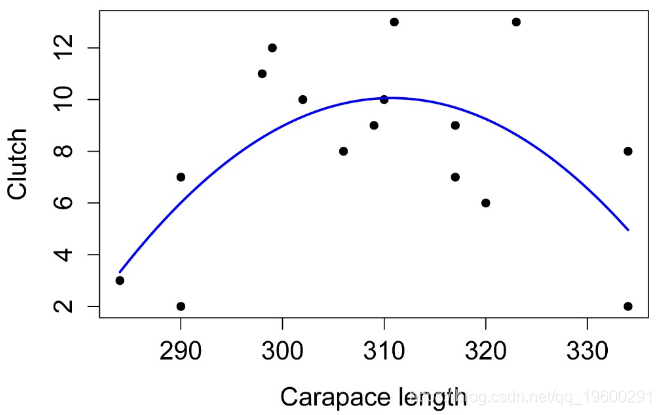拓端tecdat|R语言代码编写曲线回归:多项式回归、多项式样条回归、非线性回归数据分析
原文链接:http://tecdat.cn/?p=9508
本文将使用三种方法使模型适合曲线数据:1)多项式回归;2)用多项式样条进行B样条回归;3) 进行非线性回归。在此示例中,这三个中的每一个都将找到基本相同的最佳拟合曲线。
多项式回归
多项式回归实际上只是多元回归的一种特殊情况。
对于线性模型(lm),调整后的R平方包含在summary(model)语句的输出中。AIC是通过其自己的函数调用AIC(model)生成的。使用将方差分析函数应用于两个模型进行额外的平方和检验。
对于AIC,越小越好。对于调整后的R平方,越大越好。将模型a与模型b进行比较的额外平方和检验的非显着p值表明,带有额外项的模型与缩小模型相比,并未显着减少平方误差和。也就是说,p值不显着表明带有附加项的模型并不比简化模型好。
定义要比较的模型
生成这些模型的模型选择标准统计信息
其余模型继续此过程
|
四个多项式模型的模型选择标准。模型2的AIC最低,表明对于这些数据,它是此列表中的最佳模型。同样,模型2显示了最大的调整后R平方。最后,额外的SS测试显示模型2优于模型1,但模型3并不优于模型2。所有这些证据表明选择了模型2。 |
||||||
|
模型 |
|
AIC |
|
调整后的R平方 |
|
p值 |
|
1 |
|
99.1 |
|
-0.047 |
|
|
|
2 |
|
91.2 |
|
0.36 |
|
0.0045 |
|
3 |
|
92.7 |
|
0.33 |
|
0.55 |
|
4 |
|
94.4 |
|
0.29 |
|
0.64 |
对比与方差分析
AIC,AICc或BIC中的任何一个都可以最小化以选择最佳模型。
研究最终模型
模型的简单图解
检查模型的假设
线性模型中残差的直方图。这些残差的分布应近似正态。
残差与预测值的关系图。残差应无偏且均等。
###通过以下方式检查其他模型:
具有多项式样条的B样条回归
B样条回归使用线性或多项式回归的较小部分。它不假设变量之间存在线性关系,但是残差仍应是独立的。该模型可能会受到异常值的影响。
模型的简单图解
检查模型的假设
线性模型中残差的直方图。这些残差的分布应近似正态。
残差与预测值的关系图。残差应无偏且均等。
非线性回归
非线性回归可以将各种非线性模型拟合到数据集。这些模型可能包括指数模型,对数模型,衰减曲线或增长曲线。通过迭代过程,直到一定的收敛条件得到满足先后找到更好的参数估计。
在此示例中,我们假设要对数据拟合抛物线。
数据中包含变量(Clutch和Length),以及我们要估计的参数(Lcenter,Cmax和a)。
没有选择参数的初始估计的固定过程。通常,参数是有意义的。这里Lcenter 是顶点的x坐标,Cmax是顶点的y坐标。因此我们可以猜测出这些合理的值。 尽管我们知道参数a应该是负的,因为抛物线向下打开。
因为nls使用基于参数初始估计的迭代过程,所以如果估计值相差太远,它将无法找到解决方案,它可能会返回一组不太适合数据的参数估计。绘制解决方案并确保其合理很重要。
如果您希望模型具有整体p值,并且模型具有伪R平方,则需要将模型与null模型进行比较。从技术上讲,要使其有效,必须将null模型嵌套在拟合模型中。这意味着null模型是拟合模型的特例。
对于没有定义r平方的模型,已经开发了各种伪R平方值。
确定总体p值和伪R平方
确定参数的置信区间
模型的简单图解
检查模型的假设
线性模型中残差的直方图。这些残差的分布应近似正态。
残差与预测值的关系图。残差无偏且均等。
如果您有任何疑问,请在下面发表评论。












